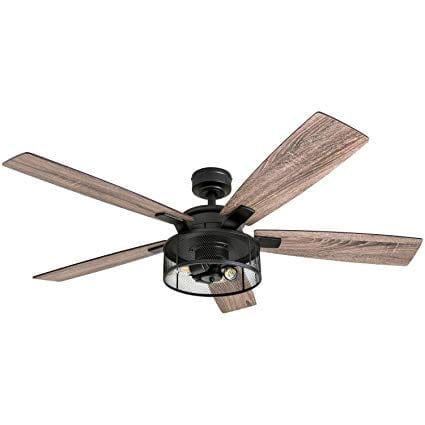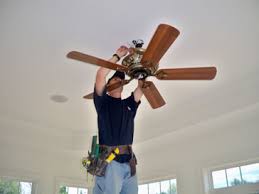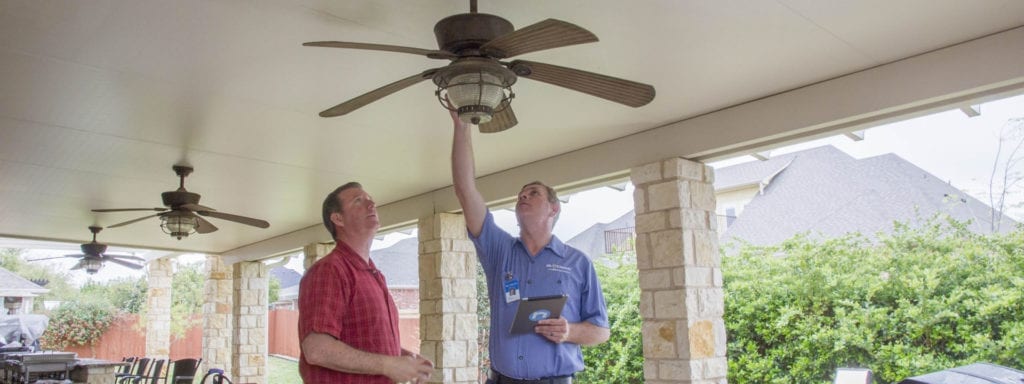How Much Do Electricians Charge To Install a Ceiling Fan?

In general homeowners can have an electrician install a ceiling fan for somewhere between $150-$325 (excludes the cost of the fan).
Ceiling fans are an excellent addition to any home, as they provide energy-efficient cooling and air circulation, making your living space more comfortable. Whether you’re building a new home or retrofitting an existing one, you might be curious about the cost of hiring an electrician to install a ceiling fan. In this article, we will explore the various factors that influence the cost of hiring an electrician to install a ceiling fan, including labor costs (about 1.5-2 hours), materials, and additional fees.
COMPARE QUOTES-
Factors Affecting Electrician Costs
Installing a ceiling fan might seem like a straightforward job, but the cost can vary significantly based on several factors. Here’s a detailed breakdown of the factors affecting the cost of having a professional electrician install a ceiling fan:
- Type and Size of the Ceiling Fan:
- Complexity: Some fans have intricate designs, multiple blades, or additional features like built-in lights or advanced control systems. These might take longer to install, driving up labor costs.
- Size: Larger fans might require more effort or additional bracing, especially if the existing ceiling box isn’t sufficiently supportive.
- Electrical Work Required:
- Existing Wiring: If there’s already an existing light fixture or fan, the wiring might be in place, making the job quicker and cheaper. However, if no wiring or fixture exists, new electrical work will be necessary.
- Switches and Controls: If you want the fan and light (if included) to be controlled by separate switches or require a special remote or wall control, the installation can become more complex and costlier.
- Circuit Capacity: If the existing electrical circuit cannot handle the added load of the fan, additional electrical work might be required.
- Ceiling Height and Type:
- High Ceilings: Installing a fan on high or vaulted ceilings often requires special equipment or ladders, making the process more labor-intensive and potentially more expensive.
- Angled/Vaulted Ceilings: Special mounting brackets or extension rods might be required for such ceilings.
- Ceiling Material: Certain ceiling materials might be harder to work with or require special care to avoid damage.
- Support and Bracing:
- Ceiling fans can be heavy, requiring solid support. If the current ceiling box isn’t rated for ceiling fan support, it will need to be replaced with a fan-rated box and brace.
- Location and Accessibility:
- If the installation location is hard to access or is in a crowded area of the house, it might take more time for the professional to complete the job.
- Local Labor Rates:
- Depending on where you live, labor costs can vary. Urban areas with a higher cost of living might have higher rates compared to rural areas.
- Permitting and Inspection:
- Some municipalities require permits and inspections for electrical work, including ceiling fan installations. This can add to the cost both in terms of permit fees and the time it takes to get approvals.
- Removal of Old Fixtures:
- If there’s an existing fixture or fan that needs to be removed first, this could increase the labor time and disposal costs.
- Additional Features and Accessories:
- Light kits, remote controls, or other accessories might increase the time it takes to install the fan.
- Travel and Miscellaneous Costs:
- If a professional has to travel a long distance to get to your location, they might charge a travel fee. They might also charge for any unforeseen complications or additional materials required during the installation.
- Warranty or Service Contracts:
- Some professionals might offer extended warranties or service contracts that could add to the initial installation cost but provide long-term peace of mind.
When considering the installation of a ceiling fan, it’s always a good idea to get multiple quotes from different professionals and understand the breakdown of costs. This will ensure you get the best value for your money and a quality installation.
COMPARE QUOTES-
Average Cost of Electrician Services
The cost of hiring an electrician to install a ceiling fan typically ranges from $95 to $175 per hour. This rate includes labor costs, as well as overhead expenses such as insurance, tools, and transportation. Most electricians will provide you with a quote for the job, which may be a flat rate or an hourly rate plus the cost of materials.

-
Cost Breakdown for Ceiling Fan Installation
Here’s a general breakdown of the costs associated with hiring an electrician to install a ceiling fan:
a. Labor: As mentioned earlier, labor costs can range from $75 to $160 per hour. A straightforward installation might take 1-2 hours, while a more complex job could take 3-4 hours or more.
b. Materials: The cost of the ceiling fan itself will vary depending on the type and features. Basic ceiling fans can be found for as little as $50, while high-end models can cost $500 or more. Additional materials, such as mounting hardware and electrical wiring, can range from $10 to $50.
c. Additional Fees: Some electricians may charge extra fees for travel or other services, such as the removal and disposal of an old ceiling fan. Be sure to ask about any additional fees when requesting a quote.
-
Money-Saving Tips
To save money on your ceiling fan installation, consider the following tips:
a. Shop Around: Get quotes from multiple electricians to compare prices and find the best deal.
b. Bundle Services: If you have other electrical work that needs to be done, consider bundling the projects together to save on labor costs.
c. DIY: If you’re comfortable with electrical work and have the necessary tools, you can save on labor costs by installing the ceiling fan yourself. However, it’s important to prioritize safety and follow all manufacturer guidelines.
The cost of hiring an electrician to install a ceiling fan will depend on various factors, such as your location, the electrician’s experience, and the complexity of the project. On average, you can expect to pay between $75 and $150 per hour for labor, plus the cost of the fan and any additional materials. To save money, consider shopping around for quotes, bundling services, or installing the fan yourself
COMPARE QUOTESWhile you can install a central air conditioner, there are cost-effective ways to maintain a comfortable temperature in your home into the spring and summer—for example, you can install a ceiling fan.
But what is the cost to install a ceiling fan? Let’s take a look at how much it will be to hire an electrician to do the job safely.
Cost to Install Ceiling Fans by Type
 Let’s discuss the types of ceiling fans and provide an estimated cost for installation. It’s important to note that these are general cost estimates and can vary based on all the factors we previously discussed, as well as regional pricing variations and current market conditions. The prices listed are primarily for installation; the cost of the fan itself is separate and can vary widely based on brand, features, and design.
Let’s discuss the types of ceiling fans and provide an estimated cost for installation. It’s important to note that these are general cost estimates and can vary based on all the factors we previously discussed, as well as regional pricing variations and current market conditions. The prices listed are primarily for installation; the cost of the fan itself is separate and can vary widely based on brand, features, and design.
-
- Standard Ceiling Fans:
- Description: These are the most common types of ceiling fans found in homes. They typically have a downrod, which is a metal pipe that connects the motor housing to the mounting bracket, allowing them to hang at least 7 feet above the floor.
- Estimated Installation Cost: $75 to $200.
- Low-Profile Ceiling Fans (Hugger or Flush Mount):
- Description: These are designed for rooms with low ceilings. They sit close to the ceiling, without a downrod.
- Estimated Installation Cost: $80 to $220.
- Dual-Motor Ceiling Fans:
- Description: These have two adjustable fan heads. They’re often more decorative and can move a significant amount of air.
- Estimated Installation Cost: $80 to $300.
- Outdoor Ceiling Fans:
- Description: Made specifically for outdoor use, they have moisture-resistant parts. These fans are rated either “damp location” (for covered patios) or “wet location” (exposed to rain).
- Estimated Installation Cost: $85 to $250.
- Industrial Ceiling Fans:
- Description: Designed for larger spaces like warehouses or commercial spaces, these have longer blades and higher speeds.
- Estimated Installation Cost: $200 to $400, largely depending on the size and complexity.
- Remote-Controlled Ceiling Fans:
- Description: These come with a remote control for operation. The installation might involve setting up the remote receiver and ensuring it works properly.
- Estimated Installation Cost: $70 to $250.
- Ceiling Fans with Lights:
- Description: These serve a dual purpose, acting both as a fan and a light fixture. Installation involves ensuring both the fan and light operate correctly.
- Estimated Installation Cost: $75 to $275.
- Energy Star Ceiling Fans:
- Description: These are more energy-efficient than standard fans, which can lead to savings in the long run. They might come with features like a DC motor, which is quieter and uses up to 70% less energy than traditional AC motors.
- Estimated Installation Cost: Similar to standard fans at $70 to $200 but may vary depending on additional features.
Remember, these are general estimates, and actual costs can vary. It’s always a good idea to get multiple quotes from professionals before making a decision. Also, the fan’s cost itself can range from as low as $50 for basic models to over $500 for high-end, designer models.
- Standard Ceiling Fans:

Choosing the Best Ceiling Fan for Your Room
When selecting a ceiling fan for your room, consider the following factors:
Room Size: Choose a fan with the appropriate blade span for your room size. For small rooms up to 100 square feet, a fan with a 29-36 inch blade span is ideal. Medium-sized rooms (100-250 square feet) can accommodate a fan with a 42-48 inch blade span, while larger rooms (over 250 square feet) may require a 52-60 inch blade span or even a dual-motor fan.
Ceiling Height: Consider the height of your ceiling when selecting a fan. Standard and dual-motor fans work best in rooms with ceilings over 8 feet high, while low-profile fans are better suited for rooms with lower ceilings.
Style and Finish: Choose a ceiling fan that complements your room’s décor. Fans are available in a wide range of styles, materials, and finishes, so you’re sure to find one that matches your taste.
Energy Efficiency: If energy conservation is a priority, opt for an energy-efficient ceiling fan with an Energy Star rating to reduce your electricity consumption.
Lighting: Decide whether you want a fan with an integrated light fixture or one without. Many fans come with built-in lighting options, while others are compatible with separately sold light kits. Keep in mind that adding a light to your fan can impact its overall efficiency, so choose LED lights for better energy savings.
Controls: Consider the type of control you prefer for your ceiling fan. Options include pull chains, wall-mounted controls, or remote controls. Some advanced ceiling fans even offer smart controls, allowing you to integrate them with your home automation system for added convenience.

With various types, styles, and features to choose from, selecting the perfect ceiling fan for your room can be an enjoyable task. By considering factors such as room size, ceiling height, and your personal preferences, you can find the ideal fan to enhance the comfort and aesthetics of your space. Not only will a well-chosen ceiling fan provide a refreshing breeze, but it can also help you save on energy costs and make your home more environmentally friendly.
COMPARE QUOTESWhere to Buy Ceiling Fans and How Much they Cost
A ceiling fan is a smart addition to any home, providing energy-efficient cooling, air circulation, and stylish lighting options. But with so many options on the market, you may be wondering where to buy ceiling fans and how much they cost. This article will guide you through the buying process and provide you with an overview of the costs involved in purchasing and installing a ceiling fan.
Where to Buy Ceiling Fans
- Home Improvement Stores
Home improvement stores such as Home Depot, Lowe’s, and Menards offer a wide selection of ceiling fans in various styles, sizes, and price ranges. These stores often have knowledgeable staff who can help you choose the right fan for your needs and answer any questions you may have.
- Lighting Showrooms
Specialty lighting showrooms often carry a diverse range of ceiling fans, including designer and luxury models that you may not find in home improvement stores. Visiting a lighting showroom allows you to see the fans on display and consult with experts who can help you make the right choice based on your room’s dimensions and style.
- Online Retailers
Online retailers like Amazon, Wayfair, and Build.com offer the convenience of shopping from home, with an extensive selection of ceiling fans from various manufacturers. Shopping online can often yield better prices, but be sure to carefully read product descriptions and reviews to ensure you’re getting the fan you want. Keep in mind that you may need to hire an electrician for installation if you purchase a fan online.
- Specialty Fan Stores
Some specialty fan stores focus exclusively on ceiling fans, offering a vast array of options and expert advice. These stores may carry unique or hard-to-find fans, making them a great choice if you’re looking for something specific or exclusive.
How Much Do Ceiling Fans Cost?
The cost of a ceiling fan varies greatly based on factors such as size, materials, design, and added features. Here’s a general breakdown of ceiling fan prices:
- Budget-Friendly Options: $75-$150
Budget-friendly ceiling fans are typically smaller in size, with fewer features and a more basic design. These fans may have pull-chain controls and may not include lighting options. They are ideal for those looking for a simple, functional fan at an affordable price.
- Mid-Range Options: $150-$350
Mid-range ceiling fans offer a balance between price and quality, with a more extensive selection of styles, materials, and features. These fans may include remote controls, lighting options, and energy-efficient motors. They are suitable for those who want a stylish and functional fan without breaking the bank.
- High-End Options: $350+
High-end ceiling fans are made from premium materials, with intricate designs and advanced features, such as smart controls, energy-saving motors, and integrated LED lighting. These fans are ideal for those who want the best in both form and function and are willing to invest in a top-of-the-line product.
Additional Costs
When budgeting for a ceiling fan, remember to factor in additional costs, such as:
Installation: If you’re not comfortable installing the fan yourself, you may need to hire an electrician. The cost of installation can range from $95 to $250, depending on the complexity of the job and your location.
Light Kits: If your ceiling fan doesn’t come with a built-in light, you may want to purchase a separate light kit. Light kits can range from $60 to $210, depending on the style and type of lighting.
Additional Accessories: Some fans may require additional accessories, such as downrods or angled mounting kits for sloped ceilings. These can range from $30 to $50, depending on the specific accessory.
When it comes to purchasing a ceiling fan, there are various options available, both in-store and online, to suit your needs and preferences. Prices can range from budget-friendly to high-end, depending on the fan’s design, materials, and features. Remember to factor in additional costs such as installation, light kits, and accessories when budgeting for your new ceiling fan.

By considering your room’s size, style, and desired features, you can find the perfect ceiling fan to enhance your space’s comfort and aesthetics. Investing in a quality ceiling fan not only adds a functional and decorative touch to your room, but it can also help you save on energy costs and create a more eco-friendly home environment.
COMPARE QUOTESHow to Install a Standard Ceiling Fan Without Existing Wiring
Installing a standard ceiling fan where there’s no existing wiring can be a complex task. Here’s a condensed guide:
- Safety First: Turn off the power from the main circuit breaker. Always use a voltage tester to ensure no current is flowing.
- Ceiling Brace: If you’re replacing a light fixture with a ceiling fan, you might need a stronger brace to support the fan’s weight. Access the ceiling from the attic, remove the existing brace, and replace it with a fan-rated brace and box.
- Cutting a Hole: If there’s no existing fixture, identify where you want the fan. Using a stud finder, locate a ceiling joist. Cut a hole for the fan brace between the joists using a saw.
- Run the Wiring: From the attic, run a new electrical cable from the closest power source to the hole. This might be a nearby outlet or another ceiling fixture. Use a fish tape to help pull the wire through.
- Install the Bracket: Attach the fan bracket to the fan-rated ceiling box according to the manufacturer’s instructions.
- Connect the Wiring: Pull the electrical cable through the bracket. Using wire connectors, connect the fan’s wires to the house wires: typically, black to black (hot), white to white (neutral), and green or bare to green or bare (ground).
- Assemble the Fan: Attach the fan’s motor to the bracket. Assemble and install fan blades. If your fan comes with a light fixture, assemble and connect it following the manufacturer’s instructions.
- Power On: Restore the power and test the fan.
Always consult the manufacturer’s installation guide specific to your fan model. If in doubt, hire a professional electrician to ensure a safe and correct installation.
Installing a Standard Ceiling Fan Without Existing Wiring
Installing a standard ceiling fan without pre-existing wiring requires careful planning and a few tools. Here’s a concise guide:
- Safety First: Disconnect the power at the main circuit breaker. Ensure safety by verifying there’s no current using a voltage tester.
- Locate Ceiling Joist: Determine where you’d like the fan. Use a stud finder to pinpoint a ceiling joist, marking the spot where the fan will hang.
- Install Brace and Box: If there’s no previous fixture, you’ll need a fan-rated brace and box for support. Cut an appropriately sized hole at your marked spot. From the attic, install the brace between joists. Secure the fan-rated box to this brace.
- Run Electrical Cable: From the attic, route a new electrical cable from a power source (like an existing outlet) to the new hole for the fan. If the distance is considerable, you might have to drill through joists. Always use protective plates over joists where you run wire.
- Install Fan Bracket: Secure the fan’s mounting bracket to the fan-rated box, adhering to manufacturer’s guidelines.
- Connect Wires: Guide the electrical cable through the bracket. Using wire connectors, match the fan’s wires: typically, black to black (hot), white to white (neutral), and green or bare to green or bare (ground).
- Attach the Fan: Position the fan’s motor onto the bracket. Follow with attaching fan blades. If it has a light kit, assemble and connect it as per the manual.
- Test: Reconnect power and test your installation.
For those inexperienced with electrical tasks, consulting or hiring a professional electrician is recommended.
Budgeting for Your Ceiling Fan Installation Cost
Lastly, you need to consider the ceiling fan installation cost. This may vary depending on the complexity of the project, the type of fan, and whether you require professional help. Usually, hiring a licensed electrician to install a ceiling fan where no existing wiring is present can cost between $100 and $500, depending on your location and the specific conditions of the job.
Remember, if you’re not experienced with electrical work, it’s safer and more prudent to hire a licensed electrician to avoid potential electrical hazards.
COMPARE QUOTES
Now that you know how to do window fans really work, you can start shopping for your fan. There are all kinds of great styles available, so you’ll likely be able to find a style that fits into your personal tastes.
How much to install a ceiling fan, wiring and switch already there
On average, ceiling fan installation jobs cost between $200 – $400. The cost per fan install can be redueced if multiple fans are being installed at one time.
Thank you for sharing this information how much does it cost to install a ceiling fan. It was useful and interesting. You indeed have written it in a layman way so that anyone can understand and work accordingly. You have done a great job.
Anyone in Phoenix az that can install 4 fans for me?
I can install is there existing wiring?
It’s OK!
I live in Puerto Rico l had a man install seven fans . Four of them had no electric running to them. The walls in Puerto Rico are made out of block so the man install the electricity out running it and covering it with the plastic covers. How much would be the cost
15.99 all included
I have a high ceiling requiring an 18 foot ladder, how much would it cost me to replace my ceiling fan
If youre just swapping fan, meaning you already have a circuit in place, meaning if you already have a switch and/or wiring, cost would be minimal, 100 to 160 us dollars.
If you need wiring and you have attic access costs are about $200-$375
If you install everything new. New fan, New wiring, new switch to control it. and have attic access. Cost are from $500-$700. Some patching will be needed when installing the switch. So that could be. A $50 addon. Another add-on could be an inspection fee which is around $85 -$120 that could be waived depending on the electrician, or promised possible future work. Inspection fee consists of safety, checking circuits around the house, see and select which circuit is safe to add another electrical item. Since its a must to grab power from somewhere to add to the new fan.
Now pls consider if there is no attic access, costs may increment up to $600 since more time is invested and more patching will be needed.
I say About 250
I would like to get an estimate on installing 3 ceiling fans with no existing wiring?
$47.39
Smartass. Lol.
That makes sense that adding extra wiring would add to the price of the install as well. I would think that would be pretty hard to do by yourself though, so it would probably be worth it to have someone else do it. I would probably electrocute myself or something if I tried to add some more wiring to my house, so I should probably call an electrician if I decide to get a ceiling fan.